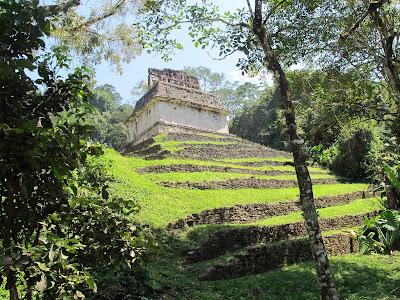The name Palenque is the Spanish word for fortification and also known as Otulum in Mayan meaning a "strong house." When entering the archeological site, your first stop is at Temple XII, Temple XIII and the Temple of Inscriptions, known as the Funerary Corridor for their deathly ornamentation and content. Just look at the figures to the right and compare it to the magnificent scale of these temples.
The ancient city's original name name was Lakam Ha, or Big Water, referencing the many streams and springs in the area. It was only this last Monday that archaeologists discovered an underground water tunnel that was built under the Temple of Inscriptions which is home to the tomb of the ancient ruler Pakal.
It was not until the 20th century that the Mexican Institute of Anthropology took over the restoration at the site and in 1952 the funeral crypt in the Temple of Inscriptions was discovered. This discovery was comparable to similar ones made in Egypt!
It is believed that the temple was specifically built atop the springs between 683 and 702. Water was tunneled from under the the funeral crypt out to the spacious esplanade in front of the temple, thus allowing a path for Pakal's spirit to reach the underworld.
It was built during the reign of Pakal but it was his successors that added houses, courtyards and the famous tower in the 8th century A.D..
The majority of the Palace's facade was painted red and blue. The north side of the tower was adorned with white stucco along with floral motifs.Many of the buildings had decorated facades and interiors with figures, stucco friezes and embossed tablets.
The south group of temples consist of three. The Temple of the Sun is the smallest of three but the best preserved. Built on top of an elevated bluff, its pillars, facade and roof comb have elaborate stucco decoration.
A view of the the Temple of Inscriptions from a far. What a beautiful setting right in the middle of the jungle. Only a small portion of the buildings have been recovered. There are over 200 buildings in this 270,000 square foot setting and I have just showcased some them. It truly is a spot not to be missed, one not over run with tourist and one that I will take my group to the end of February in 2017 where we will spend the entire morning exploring the site followed by a visit to the museum which is located at the entrance of the ruins. The museum contains an incredible collection of stucco and stone artifacts found at the site including relief carvings and hieroglyphic panels in pristine condition.
Interested in joining me on my Magic World of the Maya Tour.
The dates are February 24 - March 3, 2017 and I have a few spots left.
Please contact me at robindsg@aol.com








No comments:
Post a Comment